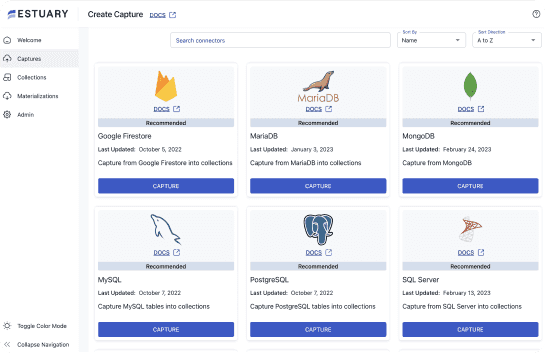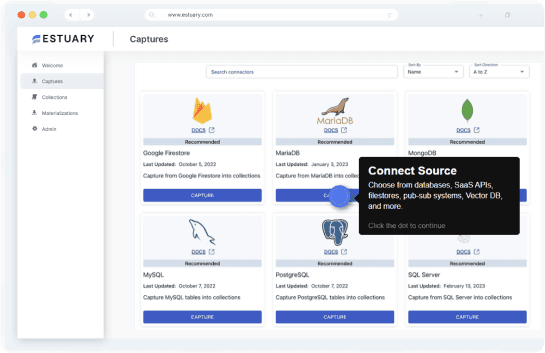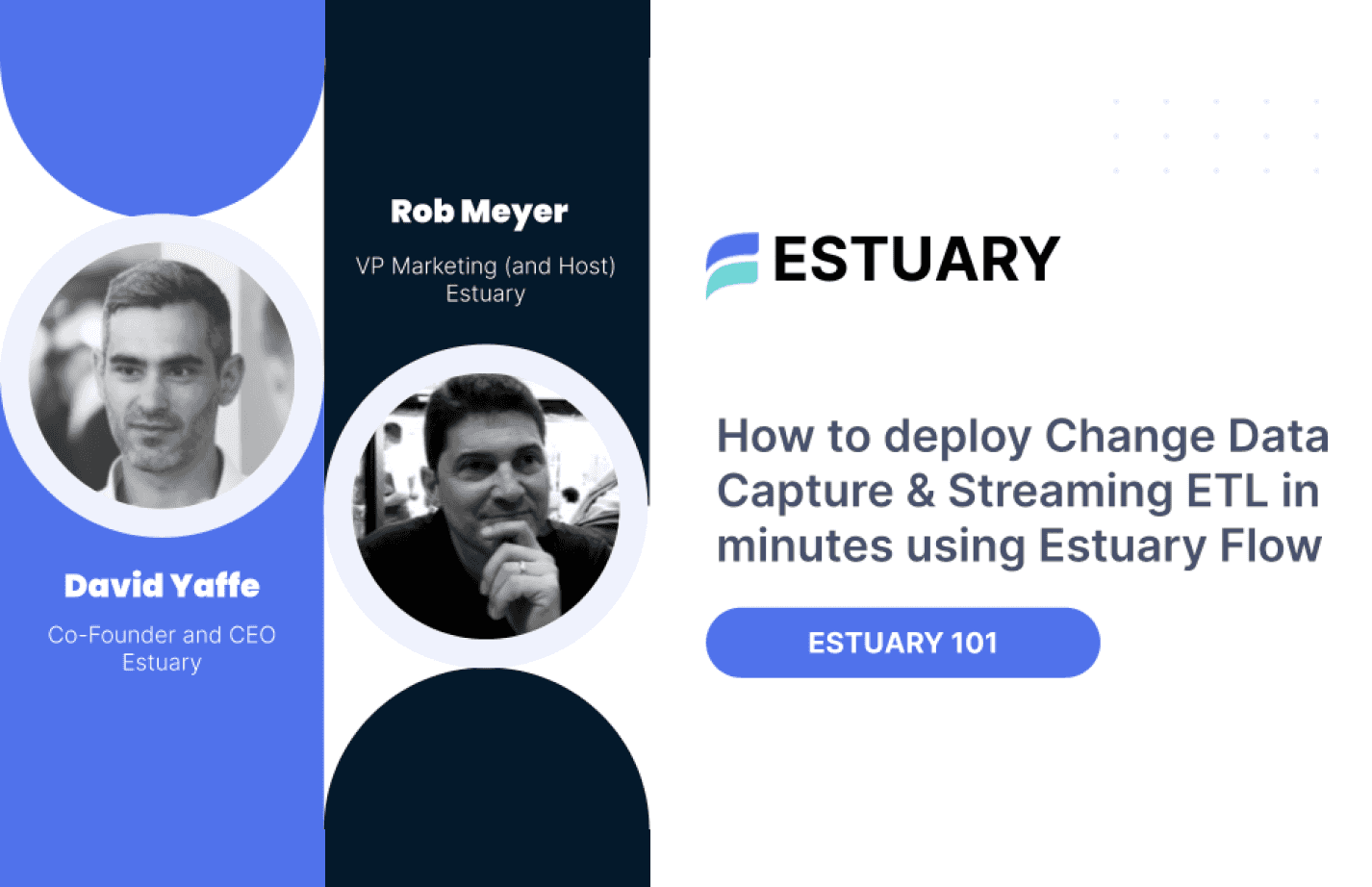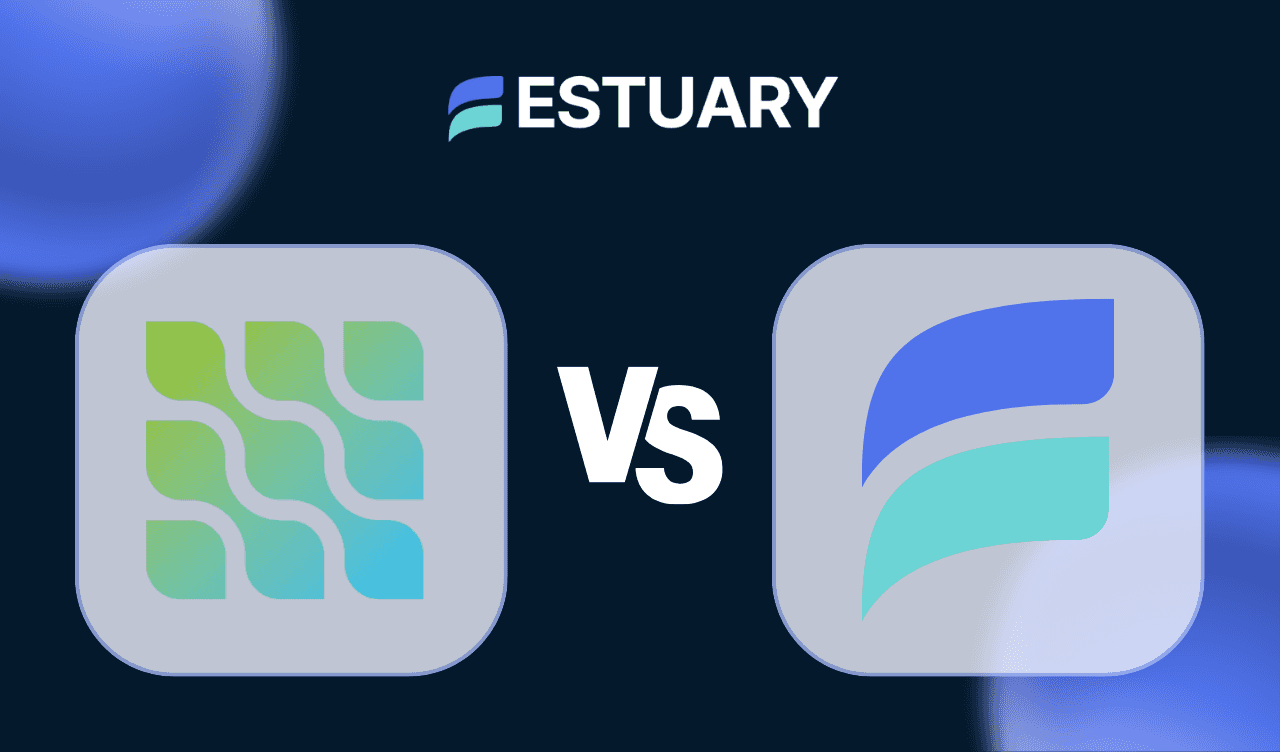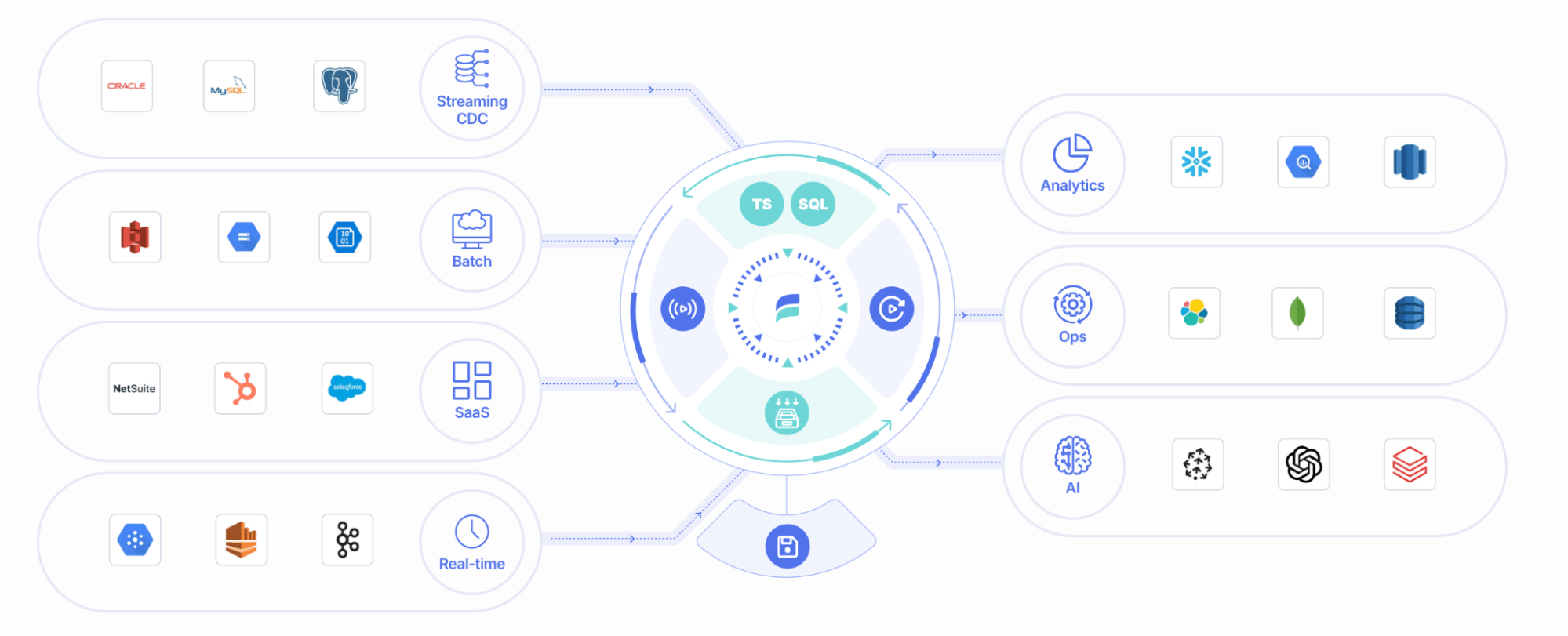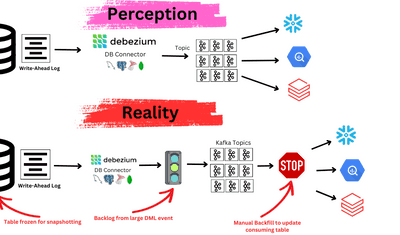
Debezium was developed within Red Hat after the release of Kafka and Kafka Connect. It quickly gained popularity as a Change Data Capture (CDC) tool for both relational and non-relational databases. When it was first launched, Debezium was one of the primary tools in the CDC space, and its adoption spread rapidly among developers and data engineers. However, several players have emerged in today’s fast-paced tech landscape, offering more powerful and user-friendly alternatives to Debezium paired with Kafka. Among these, Estuary Flow is a robust platform that simplifies CDC in a no-code environment, providing seamless integration across a wide range of data stores.
This article will dive into the core differences between Debezium and Estuary Flow, helping you decide which tool best suits your organization's needs. Whether you're looking for a more hands-on solution or prefer a managed, easy-to-use platform, we’ll explore the pros and cons of each to guide you in making an informed choice.
Debezium vs Estuary Flow: Implementation Details
Debezium is a source Kafka connector. Debezium is deployed as a connector on the Kafka Connect cluster to capture data changes from the database. The captured changes are pushed to a Kafka topic. Hence, to implement Debezium with Kafka, you need a Kafka Connect cluster and a Kafka cluster.
This setup introduces two clusters that must be maintained and monitored: Kafka and Kafka Connect. Additionally, you must decide how many Debezium connectors you need based on the data volume and schema structure. For example, you might choose one connector per database, schema, or group of tables. This configuration-heavy setup increases the initial implementation effort and associated costs.
On the other hand, Estuary Flow is single-handedly sufficient and is not based on Kafka, so there is no need to manage any Kafka or Kafka Connect clusters. It inherently captures data changes and stores them as Collections. The collections are continuously available to be materialized in other destination data stores or even emulated as a Kafka topic using Dekaf. As no extra component needs to be introduced, the implementation cost reduces drastically with Estuary Flow.
Debezium vs Estuary Flow: Connector Support and Compatibility
Debezium supports a limited set of relational and non-relational databases, including MySQL, MariaDB, PostgreSQL, Oracle DB, SQL Server, DB2, and Informix for relational databases, and MongoDB and Cassandra for non-relational stores. More recently, Debezium added support for Cloud Spanner. However, this list remains relatively narrow, and you might need to seek additional tools if your data sources include file systems, queuing systems, or third-party services. Additionally, Debezium doesn’t include sink connectors, meaning that once the data is captured, it's up to the user to configure how that data is consumed from Kafka and delivered to target stores. Having no support for sinks is one of the significant disadvantages of going with the Debezium + Kafka architecture.
In contrast, Estuary Flow offers a rich set of connectors. In addition to traditional relational and non-relational databases, Estuary Flow can capture data from platforms like BigQuery, Snowflake, Redshift and file systems such as HDFS, S3, Cloud Storage, or Blob Storage. It also supports integrations with third-party services like Jira, Notion, and NetSuite. Moreover, Estuary Flow provides a wide array of sink connectors, simplifying the process of pushing captured data to destination systems. This is handy and avoids the overhead of discovering, understanding, and implementing sink Kafka connectors from scratch.
Core Features
The core features of each platform can play a crucial role in choosing the right tool for your organization. Let's compare some of these key features.
- Form of Data Capture: Debezium is designed for real-time data capture in continuous streams, sending changes to Kafka as they happen. While it does support one-time snapshotting before starting CDC on a database, Debezium does not provide an easy way to perform regular or ad hoc snapshots or batch data capture. Estuary Flow, however, offers both real-time streaming and batch capture capabilities. You can capture data in real-time or schedule regular batches, giving you more flexibility to meet your needs.
Estuary Flow also provides an easy way to trigger ad hoc backfills from the dashboard, simplifying the workflow when an event, such as a breaking schema change, requires creating a new snapshot of the database.
- Delivery Guarantee: Debezium offers an "at least once" delivery guarantee, meaning that each captured change will be delivered at least once, but potential duplicates may be generated. On the other hand, Estuary Flow supports "exactly once" delivery, ensuring that each change is captured and delivered with no duplicates.
- ETL Transformations: Both tools support real-time data transformation, but Debezium’s capabilities are limited. It offers fundamental transformations through Simple Message Transformations (SMTs). In contrast, Estuary Flow allows for more advanced transformations, offering the flexibility to write transformations in SQL or TypeScript. This gives users much more power and flexibility when manipulating data before pushing it to other systems.
- Schema Evolution: Debezium and Estuary Flow support schema evolution, automatically adapting to changes in the data schema over time. However, there is one significant difference. Debezium can only capture the schema changes and propagate them to Kafka. As Debezium + Kafka architecture does not have native support for sink connectors, you must ensure that the sink connectors can correctly propagate the schema changes to the target data stores. As an end-to-end solution, Estuary Flow can capture schema changes and propagate and apply them to target data stores.
- Backfill: Debezium backfills are pretty cumbersome and can impact database performance. Suppose you have to spin up a new consumer that needs historical and real-time change events. Unless the data is retained in a Kafka log forever (cost inefficient) or the topic can be compacted sufficiently, you must manually trigger backfills. The snapshots could likely fail in case of a vast data load for backfills. Also, there is a high possibility of performance issues during such backfills. Estuary Flow, on the contrary, can perform such backfills quite seamlessly. It will go easy on the database, ensuring it performs well for your application use cases. Estuary supports different backfill modes: normal, precise, only changes, and without a primary key. You can read more about these different backfill modes here.
The Cost
Several cost factors should be considered when evaluating tools. These factors include implementation, operational, maintenance, and tool-related expenses.
Implementation Cost
Debezium's implementation cost is relatively high. A source Kafka connector will run on the Kafka Connect cluster and push out data on the topic. To implement Debezium, you must assemble the Kafka Connect and Kafka clusters. Also, you need to understand the different configuration options available with the Debezium connector corresponding to the database from which you need to capture the data. This will increase the time it takes to assemble the Debezium connector, thus increasing the implementation cost.
Debugging Debezium or adding any feature to extend its functionality to support your use case requires a thorough knowledge of Java. Debezium is based on Java, and one should be well-versed in Java architecture and codebases to understand this Java-based tool and navigate its source code.
On the other hand, Estuary Flow is straightforward to implement, as it’s a fully managed service. It has an intuitive user interface where you can define connectors and configuration settings using simple, well-defined text fields. This reduces setup time and lowers the entry barrier for non-developer team members. There's no need for separate Kafka and Kafka Connect clusters; all underlying infrastructure is managed for you, reducing implementation complexity.
Any support for additional features can be requested from the Estuary team, and they can prioritize your request while you sit back and get it delivered to you in the minimum time possible. The Estuary developers who own the Flow application framework and the underlying Gazette streaming framework will work on the feature request. This ensures the change is reliable and robust and can work at a production scale. This is a win-win situation as you need not go through an alien codebase trying to connect the dots, and the Estuary team, who already owns the expertise in this area, can get the change done appropriately and in minimal time and effort.
Operational/Maintenance Cost
Debezium requires Kafka Connect and Kafka clusters, which increases the operational overload of maintaining these clusters. Both clusters must be monitored and maintained for availability and scalability to ensure seamless functioning of the change data capture functionality. Not only that, but even the Debezium connectors need to be maintained. Also, you are more or less on your own with minimal to no support from the Debezium community. Debezium is an open-source tool, and the community is not bound by timelines or guarantees for support.
Estuary Flow is low-maintenance as it is a managed cluster. The Estuary team is easily approachable on Slack and exceptionally engaging and responsive. Resolution time is less, and they don't hesitate to implement fixes to unblock you.
Scalability Cost
Debezium and Estuary Flow are scalable, but the Debezium scaling process requires manual intervention. As your data volume or usage grows, you must manage and scale the Kafka and Kafka Connect clusters yourself.
Estuary Flow, however, automatically handles resource scaling in a serverless mode, making it much easier to adapt as your needs change.
Cost of the Tool
Debezium is an open-source solution, so there’s no cost for the software itself. You only pay for the infrastructure required to run Kafka and Kafka Connect, though enterprise versions of these tools are available at a cost. While this open-source stack looks like a pretty lucrative option at first sight, there is a high hidden cost associated with this option, as you need trained developers who can implement, maintain, scale, and debug the infrastructure.
On the other hand, Estuary Flow is a managed service that requires a subscription based on usage. While it incurs costs, these are typically 2-5 times lower than other vendors. Estuary Flow’s pricing structure also benefits from economies of scale, with costs dropping as data volumes increase.
Let's explore some pricing highlights, which can be analyzed using the Estuary’s Pricing calculator. We will find out the estimated cost for 10 connector instances. The Estuary’s estimated cost for moving 500 GB of data is $1,300. This non-proportional cost increase grows to only $1,800 for moving 1TB of data and $2,280 for moving 1.5TB of data. The corresponding pricing calculations for other competitive products are around 2-5x more than for the Estuary.
Security
Security is yet another aspect when choosing between tools. Debezium + Kafka is a self-managed cluster, so you will ultimately own security. You will be responsible for ensuring that both Debezium and Kafka clusters are secure and can handle the data securely in transit and at rest. This involves ensuring that the network is foolproof from external attacks and that all the possibilities of data leaks are handled. Also, the data is encrypted at rest. The Kafka endpoint is secured; only trusted parties can connect to the Kafka cluster.
Estuary has an option for public and private deployment. For stricter security requirements, it is advised to go for private deployment options. Under private deployment, the end-to-end pipeline from source to target data stores is handled by Estuary Flow, which ensures that the complete pipeline is secured and the data is protected. Estuary's public deployment offering will suffice for use cases with less stringent data security requirements.
Estuary Flow's essential security features include RBAC, centralized access management, a zero-trust network model, and data localization. It also complies with well-known HIPPA, GDPR, CCPA, and CPRA compliance guidelines and is SOC2 Type II certified, making it one of the most secure applications.
Final Verdict: Debezium vs Estuary Flow - Which CDC Tool is Best for You?
When evaluating Debezium vs Estuary Flow, Debezium is a solid choice if you are committed to an open-source approach, have the specialized resources to manage Kafka and Kafka Connect clusters, and need a highly customizable solution. However, the maintenance and scaling effort required in the long run can be significant if your needs grow over time.
On the other hand, Estuary Flow offers a more straightforward and user-friendly approach. It’s easier to implement, requires less ongoing maintenance, and has a responsive support team. If you prefer a managed, low-maintenance solution that can handle complex CDC use cases with minimal setup, Estuary Flow may be the better choice for your organization.
Ultimately, the choice between Debezium vs Estuary Flow depends on your specific requirements for connectivity, data integration, performance, scalability, reliability, and security. Considering your short-term and long-term needs, you can make a well-informed decision aligning with your business goals

About the author
Shruti is an accomplished Data Engineer with over a decade of experience, specializing in innovative data solutions. Her passion for exploring new technologies keeps her at the forefront of advancements in the field. As an active contributor to open-source projects and a technical blog writer, Shruti shares her knowledge with the wider community. She is also an Udemy author, with multiple courses in data engineering, helping others build expertise in this domain.

